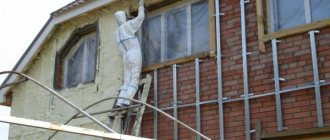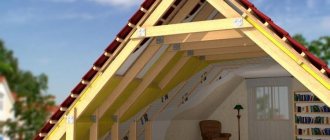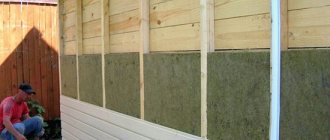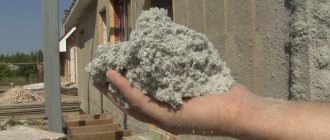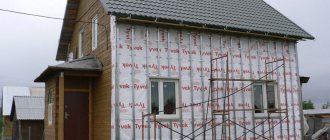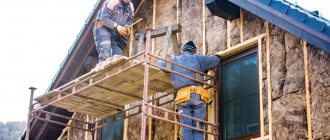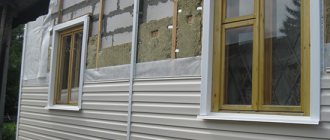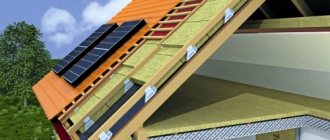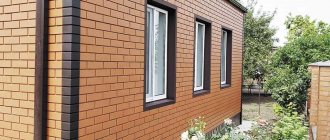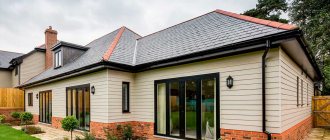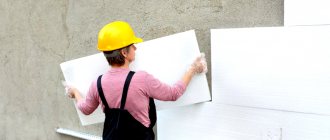| Place | Name | Characteristics in the rating |
| The best insulation for external walls |
| 1 | Polyurethane foam (PPU) Wetisol SprayFoam-50 | The most effective external insulation |
| 2 | Extruded polystyrene foam (XPS) PENOPLEX Comfort | Durable insulation with high strength |
| 3 | Ecowool SoundGuard EcoAcoustic | The most environmentally friendly insulation |
| 4 | Foam plastic PSB-S 15 | Best price |
| 5 | Thermal insulation ETIZ Steam glass Strong 180 | Thermal and noise insulation of a new generation |
| The best insulation for walls from the inside |
| 1 | Wicanders technical plug | Universal natural insulation |
| 2 | Fiberboard boards GB-600 | Innovative thermal insulator |
| 3 | Mineral wool ISOVER Optimal | Convenient installation, high popularity |
| 4 | Liquid thermal insulation Altermo Standard | The thinnest layer of thermal insulation |
| 5 | Penofol 2000 | Combined insulation |
Reflective type thermal insulation
Insulation materials, called reflective or reflective, work on the principle of slowing down the movement of heat. After all, every building material is capable of absorbing this heat and then radiating it. As is known, heat loss occurs mainly due to the exit of infrared rays from the building. They easily penetrate even materials with low thermal conductivity.
But there are other substances - their surface is capable of reflecting from 97 to 99 percent of the heat reaching it. These are, for example, silver, gold and polished aluminum without impurities. By taking one of these materials and constructing a thermal barrier using polyethylene film, you can get an excellent thermal insulator. Moreover, it will also serve as a vapor barrier. Therefore, it is ideal for insulating a bathhouse or sauna.
Today's reflective insulation is polished aluminum (one or two layers) plus polyethylene foam (one layer). This material is thin, but gives a tangible result. So, with a thickness of such insulation from 1 to 2.5 centimeters, the effect will be the same as when using a fibrous heat insulator from 10 to 27 centimeters thick. As an example, let's name Armofol, Ecofol, Porilex, Penofol.
One of the types of reflective thermal insulation.
Advantages of sawdust
An important advantage of sawdust is its low cost.
A bag with a capacity of 50 liters costs on average 100-300 rubles, a compressed briquette weighing 20 kg will cost 200-230 rubles. And with some luck, you can get wood waste for free. Many industries are ready to give them away for free in order to save themselves the hassle of garbage disposal.
According to the thermal insulation characteristics of sawdust, covered with a layer of 10 cm, corresponds to 8-9 cm of mineral wool or 7 cm of polystyrene foam
However, the affordable price is not the only advantage of sawdust. This material has amazing durability.
Synthetic insulation materials, such as polystyrene foam, polystyrene foam and polyurethane foam, last on average about 30 years (PIR boards retain their stated characteristics for up to 50 years). Mineral wool “lives” a little longer - 50-70 years. Shredded wood can retain its performance properties for 100 years or even more.
It is also worth noting such a useful quality for insulation as vapor permeability.
Sawdust “breathes” perfectly, which has a beneficial effect on the microclimate of the house. In addition, the developer has the opportunity to save on vapor barrier membranes, which are simply not needed for this type of thermal insulation.
But that is not all. A house insulated with sawdust is never too damp or dry.
The fact is that crushed wood is able to absorb condensation if the air becomes too humid, and evaporate it in the opposite situation. Polymer materials cannot boast of this.
And finally, let us mention the environmental friendliness of sawdust. They do not emit unpleasant “chemical” odors and do not pose a threat to the health of the inhabitants of the house.
Ecowool
As the name suggests, the majority of this insulation (about 81%) is recycled paper. The remaining 19% comes from antiseptics against pests and fire retardants that protect against fire. The material is extremely simple to manufacture, so it is inexpensive.
A layer of sprayed ecowool 150 mm in energy saving corresponds to a brick wall 4.5 bricks thick.
But what is more important is that paper insulation (aka ecowool) copes with its responsibilities perfectly. Just 15 cm of paper mixture corresponds in terms of heat conservation to a brick wall 4.5 bricks thick! In this case, the layer turns out to be homogeneous, without seams and voids. It is also important that it “breathes” perfectly, and therefore does not need a vapor barrier.
Another advantage of ecowool is that it can also serve as a sound insulator. A 100 mm thick layer reduces the noise level by approximately 60 dB.
Fire safety.
For material that is shredded paper, this issue is of great importance. As practice shows, cellulose insulation does not ignite upon contact with fire, but only smolders and quickly fades, having lost a heat source. But still, it’s worth dwelling on fire retardants in more detail.
Some manufacturers use ammonium sulfates and phosphates, which emit a pungent and unpleasant odor. But this is not the main problem. The trouble is that over time these additives lose their fire-retardant properties. Therefore, it is better to purchase material impregnated with borax (borax). This fire retardant does not have the disadvantages described above.
Borax protects not only from fire, but also from pests. Rodents cannot tolerate this substance, so they will not settle in the insulation layer.
Water resistance.
It would seem that the paper is not “friendly” with her. First of all, we note that it is impossible to allow any insulation to get wet - this has a very bad effect on its properties. But if an accident does occur, the cellulose fibers will retain some of the moisture that gets on it in the upper layers, from where it will quickly evaporate, so that the material will not be critically damaged.
Cellulose insulation is used to protect walls, attics, attics, roofs and floors on joists. But you can’t lay it under a screed - under the weight that has fallen, the loose material will become dense, which will reduce its useful properties to zero
The consistency of ecowool resembles fluff.
Ecowool is supplied in a compacted state (briquettes), which means that it must first be loosened. If manual installation is intended, this can be done with any convenient tools in a large container. Then the paper pulp is poured into the cavities of frame walls and ceilings. It is very important to observe the application density: for horizontal structures it is 35–40 kg/m³, for vertical structures it is 60–70 kg/m³. Obviously, this work requires a lot of time and effort. It is much faster and easier to apply the material using a special blow molding machine. It loosens the insulation itself and delivers it under pressure over a distance of up to 200 m horizontally and 40 m vertically. At the same time, ecowool penetrates into the smallest cavities and forms a uniform heat and sound insulating layer. The application density can be adjusted.
In what cases is this relevant?
Insulating walls from the inside certainly improves the thermal performance of a house. But this is an unconventional technology, because usually they try to do external insulation. However, there are situations when there is no other choice.
Internal thermal insulation is recommended only when external insulation is not possible
This option is also relevant for apartment buildings. It helps not only to increase the comfort of your home, but also to prevent the occurrence of troubles such as mold or mildew.
Granular foam glass
Foam glass in the form of granules is the optimal heat insulator for floors on the first floor of a building. Unlike, for example, expanded clay concrete, the material is not hygroscopic, which means there are no conditions for wood to rot. The vapor permeability of expanded clay is 0.21 mg/(m•h•Pa), and foam glass is 0.001–0.005 mg/(m•h•Pa), moreover, it has half the density, so when producing heat-insulating backfill, You can get by with a layer half as thin. But as for the price, there is a clear advantage of expanded clay, which costs significantly less than granulated foam glass: 1450–2750 rubles. versus 6,000-12,000 rubles. per cubic meter.
Flaws
So, it would seem that there are no obvious problems. So why is this insulation not popular among us? There are several reasons.
Let's start with the fact that in Russia there are no standards for the composition of paper insulation, so the manufacturer can regulate the quality of the product itself. It is unnecessary to say what this sometimes leads to.
During installation, there are also moments of risk. Workers interested in saving material may apply it in a looser layer than necessary. This means strict control is needed.
Although ecowool does not burn, it smolders, which means that when insulating attics and attics, you will have to insulate chimney pipes with non-combustible materials.
And finally, the most noticeable drawback is the price. The material itself is cheap, but workers’ services and equipment depreciation will also have to be paid for. The average cost of 1 m³ on a turnkey basis varies from 1,700 to 5,200 rubles.
Read more in the article “Boo...smears”
7
Conclusion
Thermal insulation inside walls is not the most popular way to reduce heat loss in a room. Reduced area, the need for more careful calculations to determine the “dew point” and other disadvantages force owners of apartments and private houses to choose external insulation. Moreover, installing insulation outside minimizes the risk of dampness in the premises.
At the same time, if insulation on the façade side fails (the appearance of the house is disrupted, there are expansion joints at the insulation site), the internal placement of heat-insulating materials can also be made more effective. If you use special technologies and take measures to prevent the appearance of dampness on the walls, the effect will be no worse than that of external thermal protection.
Mode of production
The material is obtained as follows. At the first stage, a mixture (charge) is prepared from finely ground silicate glass and a carbon-containing gas former, which can be coal coke, anthracite, limestone or marble. Then the mixture is sent to a tunnel furnace, where at a temperature of about 900–1000°C the glass particles are softened to a viscous-liquid state, and gaseous CO2 and CO released as a result of carbon oxidation foam the glass mass, forming closed pores in it. The final product can be presented in the form of granules and crushed stone of different fractions, slabs, blocks. Let's talk about the most popular forms of foam glass in private housing construction.
Thanks to its exceptional properties, foam glass (otherwise known as cellular glass) can provide excellent heat and sound insulation of various building structures: roofs, walls, ceilings, etc.
How to thermally insulate the walls of a house or apartment?
There are several ways to insulate the walls of a house or apartment:
- Make a hinged ventilated facade. In this case, non-combustible materials must be used.
- Install the insulating material and then apply thin-layer plaster. An example is a wet facade.
It is worth clarifying that, according to the laws of physics, it is safer and more effective to insulate a house either comprehensively - both inside and outside, or only outside. Then the wall will not get wet or moldy. If it is impossible to sheathe the outside of the house, for example, the building is an architectural monument, then it is permissible to insulate it only on the inside. But then you need to make calculations so that the dew point does not end up in the load-bearing structure of the wall.
The material for the outer part of the wall must be weather-resistant. Insulation for interior decoration is environmentally friendly.
Recommendations for carrying out insulation work
Insulation work is best carried out in the summer, when air humidity is minimal.
The walls for insulation in the room must be perfectly dry. You can dry them after additional plastering and finishing work on leveling the surfaces using construction hair dryers and heat guns.
Stages of surface insulation:
- Cleaning the surface of decorative elements - wallpaper, paint.
- Treating walls with antiseptic solutions, priming the surface with deep penetration into the layers of plaster.
- In some cases, when installing polystyrene foam and electric heating elements, the walls are pre-leveled using waterproof plaster for bathrooms.
- Installation of insulation must be carried out according to the instructions prescribed by the manufacturer for this type of material.
- Installing a protective partition for applying the final finish, or covering the surface with a construction mesh and plastering it.
- Creating a single composition with the overall design of the room.
Insulating walls inside a house is one of the most effective ways to protect your home from the penetration of cold and the negative effects of condensation; the main thing is to follow the technological sequence of steps. You can read more about the technology of insulating a home from the inside in this material.
Extruded polystyrene foam
Extruded polystyrene foam (EPP) is a progressive and modern material; it is quite closely related to the polystyrene foam familiar to each of us. Both insulation materials are made from polystyrene, but using fundamentally different technologies. And this causes significant differences in consumer properties.
Extruded polystyrene foam XPS
During the production of polystyrene foam, polystyrene granules are repeatedly treated with hot steam, which is why they increase in volume.
But at the same time, the micropores of the material increase. At first, the insulation copes with its duties perfectly. But over time, under the influence of moisture and other aggressive factors, it simply crumbles into individual grains. Although even polystyrene foam that has just “come off the assembly line” has rather low strength. It crumbles easily and has almost no resistance to bending.
In the case of extruded polystyrene foam, the granulated raw material is placed in a reactor where it is subjected to heat and pressure.
Then, when the polymer melts, the pressure is released, which leads to active foaming, and the resulting mass is passed through an extruder.
The result is a material consisting of closed cells with strong molecular bonds. This implies the main advantage of extruded polystyrene foam. It is approximately 5 times stronger than polystyrene foam.
Extruded polystyrene foam is an effective insulation material. A 10 cm thick EPP board retains heat as well as a 150 cm thick brick wall.
Lightweight, usable roof system for pedestrian loads with plastic supports.
High strength allows the EPP to withstand quite significant loads, and this, in turn, provides a wide range of applications. This insulation is used not only for walls and ceilings, but also for foundations, blind areas, and used roofs. It is used to fill well masonry during the construction of brick houses. It is included in the design of many sandwich panels.
It is also worth noting that polystyrene foam is an exceptionally lightweight material.
It puts virtually no load on the walls and foundation, and also does not create problems during installation
.
The slabs lend themselves perfectly to mechanical processing, and glue and dowels are enough to secure them to the walls.
An important advantage of polystyrene foam is its almost complete waterproofness.
. Even when dipped, it absorbs less than one percent of the liquid.
But unfortunately, EPP has quite noticeable disadvantages.
The first, and probably the main one, is
extremely low vapor permeability.
In simple words, this material does not “breathe” well. You should not insulate the walls from the inside with it - settling condensation will lead to the formation of mold. Experts recommend using this heat insulator outside and covering it with plaster. You can also lay polystyrene foam boards inside frame structures, but it is extremely important to create an air gap for proper ventilation.
Like regular polystyrene foam, extruded polystyrene foam is “afraid” of certain chemical reagents.
For example, bitumen mastics, which are used as waterproofing. Under their influence, EPP becomes soft and sometimes even dissolves.
To avoid blowing through the seams, EPP boards should be laid in two layers, with bandaging
More details in the article “Foam plastic”
3
Straw
The design of the wall of a domed house insulated with straw blocks
It is difficult to believe that in the twenty-first century builders still use straw, but nevertheless it is so. Threshed, crushed and well-dried stems, pressed into blocks, can serve as both thermal insulation and wall material. “Bricks” are laid between the frame posts and plastered both outside and inside.
Straw blocks have many advantages. These are high thermal insulation characteristics, the ability to absorb irritating noise, low weight, and, importantly, low price. The average cost of one block 36 × 46 × 75 cm is 150-300 rubles.
Unfortunately, there are also many disadvantages - flammability, “phobia of water”, susceptibility to biological damage and low load-bearing capacity. Turning to straw when constructing a year-round residential building is quite risky. But in small summer buildings it can be used without fear.
Important!
The frame can only be filled with straw blocks after the roof has been erected. This is necessary to protect the material from getting wet.
Rye straw is considered the best raw material for the block (rodents do not like it), but wheat straw is also used. The optimal size of the “brick” is 40 x 50 x 50 cm
9
Flaws
High price.
Basalt wool is quite expensive. One cubic meter of material costs from 1,500 to 6,500 rubles. (depending on density and a number of other factors). Such a high price tag is primarily due to the complexity of production and the need to use expensive equipment, in particular blast furnaces.
Use of environmentally unsafe materials.
Stone wool consists of more than 95% of stone itself, but it cannot be called an absolutely natural product. To prevent the boards from falling apart into fibers, manufacturers are forced to use binders, in particular formaldehyde resins. Of course, self-respecting companies use them in minimal quantities, but there is always the possibility of “running into” a low-quality product that emits toxic fumes.
There is only one way to minimize risks - by checking the documents for the products. The laws of the Russian Federation require manufacturers of heat-insulating materials to obtain a Fire Safety Certificate, as well as an Expert Opinion on compliance with current sanitary standards and rules.
Reviews
When choosing the best way to insulate walls from the inside, they take into account not only the characteristics of the materials, but also user reviews. Owners of houses that have already received internal insulation with this material note that the positive aspects of installing such thermal protection outweigh the disadvantages. And they leave the following reviews:
When choosing a suitable insulation option, I opted for a 5-centimeter layer of polystyrene foam. I fastened the sheets without a frame - onto ceresite, like tiles. The result of installing the insulation was the complete drying of the damp corners and the northern wall of the house. Due to poor waterproofing, the walls practically did not dry, preventing wallpaper from being hung. Now the sticker has become possible, and gas consumption for heating has decreased by almost 20%. Andrey, Murmansk
I've read a lot of arguments against insulating from the inside. I don’t understand why they are advising to abandon a good and quite effective option to reduce heat loss through walls. More than 3 years have passed since the renovation (foamed polyethylene was used for insulation), the house is warm and there is no dampness. Those who have problems installing insulation inside a building probably either chose the wrong material or installed it incorrectly. Perhaps the reason is also poor ventilation. Mikhail, Voronezh
I used penoplex (EPS) for insulation. The advantages of the material include the absence of harmful dust during installation (there is no need to use personal protective equipment), resistance to mechanical stress and excellent heat-shielding properties. The house became noticeably warmer. Among the disadvantages are complex installation, which requires some experience, and flammability - they say that if such insulation catches fire, black and acrid smoke will appear. Oleg, Kursk
The main mistakes when choosing insulation for walls
Let's look at the main mistakes when choosing thermal insulation materials. This will save you from unnecessary expenses and rework.
- Saving. A low-quality thermal insulator will not only quickly become unusable, but will also compromise the integrity of the wall. Poor insulation can cause mold, mildew, or even the collapse of part of the façade. Therefore, when choosing insulation, you should not take the cheapest product in the store.
- Fire safety. The insulation must not only be non-flammable or low-flammable, but also environmentally friendly. When choosing between synthetic and natural insulation, give preference to the latter.
Disadvantages of sawdust
Of course, speaking about the advantages of sawdust, we cannot help but talk about the disadvantages. The first and main one is fire hazard.
. Despite the fact that compacted insulation does not readily ignite and smolders rather than blazes with a bright flame, it is much more afraid of fire than other materials.
In a house insulated with sawdust, it is important to strictly follow fire safety rules and keep a fire extinguisher on hand. A fire alarm would also be a good idea.
When giving preference to wood insulation, you should take into account that mice can live inside frame walls.
However, this applies to all fill-in insulation. A fine-mesh metal mesh will provide reliable protection against rodents.
Another problem is susceptibility to rotting,
which can occur due to leaks, ineffective ventilation, etc.
And finally, the complexity of the installation process.
Sawdust cannot simply be poured out of a bag and left to its own devices. They will settle, decreasing in volume by one and a half to two times, and voids will form at the top of the walls, which will become bridges of cold. Tamping required. It is made using a small wooden block or cutting a board every 20 cm of material.
In addition, pouring with lime milk is advisable. It makes tamping more efficient and also serves as an antiseptic for the wood, preventing possible rotting.
Read more in the article “And there is sawdust in my wall...”
8
Sawdust
Sawdust insulation can confidently be called a time-tested technology. In the USSR it was actively used, which is reflected in SNIP II-A.7-62 “Construction heating engineering. Design Standards" 1962. Moreover, sawdust-fill houses erected in the 19th century still stand and are in use today.
To be fair, it is worth noting that most old buildings have rather thin walls - about 10-12 cm, and in cold weather they have to be heavily heated. In modern houses, the layer of sawdust insulation is much thicker - 30-35 cm, and they fully comply with heat transfer resistance standards. But what makes progressive developers abandon polyurethane foam and stone wool in favor of wood waste?
Comparison of materials
- Mineral wool is a product of melting basalt rocks.
- Glass wool is a coarse fibrous material obtained by melting glass, sand, soda, borax, and limestone.
- Foam plastic is a foamed cellular plastic.
- Polystyrene is the result of the polymerization of styrene.
- Extruded polystyrene foam - foamed polystyrene.
- Polyester fiber is a product of processing recycled plastic materials. The synthetic fibers of this insulation are similar to padding polyester.
| Insulation | pros | Minuses |
| Basalt group mineral wool | • low thermal conductivity; • non-flammable, fire resistant; • does not emit smoke when exposed to fire; • light; • easy to install; • vapor permeable; • withstands the effects of alkalis and acids; • vibration-resistant; • dielectric; • environmentally friendly. | • does not hold its shape well; • special protection is required when working. |
| Glass wool | • budget; • weighs little; • high chemical resistance; • elastic and durable; • environmentally friendly; • vibration-resistant; • non-flammable. | • Tiny particles of material may cause respiratory or visual damage. For installation you need special clothing, a respirator, safety glasses, and gloves. • Hygroscopic; • Does not hold its shape. |
| Styrofoam | • inexpensive; • easy; • does not absorb water; • durable, withstands mechanical loads. | • highly flammable; • when burning, it releases toxic substances; • crumbles and crumbles during operation; • low density; • precise cutting is required during installation; • easily destroyed under the influence of technical liquids or their vapors - gasoline, acetone. |
| Expanded polystyrene | • not hygroscopic; • low thermal conductivity coefficient; • keeps its shape for a long time; • withstands compressive loads. | • highly flammable; • difficult to install - you need to cut the material precisely; • easily destroyed by insects and rodents. |
| Polyester fibers | • keep their shape; • not hygroscopic; • low thermal conductivity; • hypoallergenic; • lungs. | flammable. |
The best manufacturers
According to builders and customer reviews, the most reliable brands are:
- Isover is a subsidiary of the French construction concern Saint-Gobain. Izover is the only manufacturer in the Russian Federation that simultaneously produces two types of mineral wool - basalt and quartz. The company’s catalog also includes sound and heat insulation solutions made from glass and mineral fibers, expanded polystyrene (for walls, roofs, pipelines, etc.)
- Knauf is a German manufacturer of construction equipment and materials.
- Rockwool is an international group of companies headquartered in Denmark. The Rockwool division is engaged in the development and production of stone wool for heat and sound insulation, as well as fire protection of all types of buildings, ships, and equipment. The materials are made from gabbro-basalt rocks.
- URSA is one of the most famous Spanish companies producing heat and sound insulation materials. The company's name has become a household name in construction. URSA products have been represented on the Russian construction market for more than 20 years. The products meet international quality standards, are safe, environmentally friendly, and durable.
- Penoplex is a Russian manufacturer that produces polymer materials for hydro- and thermal insulation, decorative and finishing works.
- TechnoNIKOL is a Russian manufacturer of thermal and waterproofing insulators, as well as roofing materials.
- ShelterEcoStroy is a Russian manufacturer of environmental insulation materials. The products are distinguished by high heat and sound insulation qualities. The company's product range includes solutions for wind protection and insulation of frame houses, thermal insulation of walls, basements and basements, roofs, as well as technological equipment.
